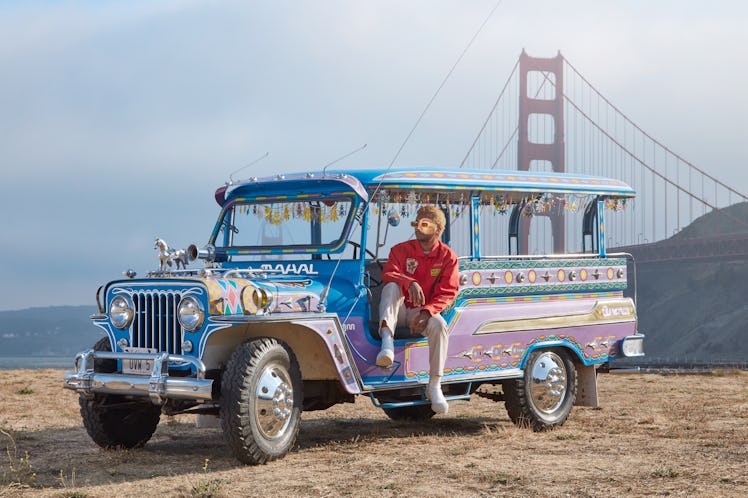Chaz Bear is hitting the road in a mode of transportation that’s not commonly seen Stateside.
“I was a fan of Jeepneys since I was a kid,” he tells W magazine in a recent phone interview, referencing the popular mode of transportation from the Philippines—its name a contraction of the words “jeep” and “jitney.” “My mom came back from the Philippines one trip, and she brought me a toy Jeepney. It’s been with me ever since. Those things were so badass to me and still are.”
The artist, known musically as Toro y Moi, grew up steeped in Filipino culture. But it’s on his seventh album, called “Mahal,” that Bear has leaned fully into his heritage as a source of inspiration. He’s been working for the past five years on the Seventies funk-inspired album, which released April 29—it’s also the first one he’ll be putting out under his new label, Secretly Group’s Dead Oceans.
“Mahal” translates to “love” in Filipino, the official language of the Philippines, from where Bear’s mother’s family emigrated in the late Seventies.
“I wanted [the name, ‘Mahal’] to resonate on multiple levels,” Bear says. “One, obviously, there’s a Filipino cultural connection. I also wanted it to have a psychedelic rock reference, and I think ‘flower power’ and love are a great signifier of what you’re about to listen to.”
Influence-wise, “Mahal” doesn’t stray far from previous albums Bear has recorded, though it is stylistically experimental. Car sounds—tires on the road, a vehicle speeding up, even a man yelling “push it!”—are woven throughout the album as intros and outros.
“My first iteration of the record didn’t have jeep sounds and it didn’t have outros,” Bear says. “I went back and re-thought the vision through. The pandemic gave me that time to think about choices like that and concept something fun.”
Some of the outros, he explains, are actually demos from “Mahal” recording sessions, distorted to sound like a car radio. Inspired by TikTokers, Bear decided to be less precious about unreleased demos and include them on “Mahal.”
“The Internet definitely sparked something in me that made me disconnect from the idea of [demos] being mine,” Bear says. “I was so possessive of my music, and I still am in some ways, but to me, letting go of demos was a cathartic process.
“I would see kids make shit on TikTok. It’s like, how are you so comfortable dropping music for free all the time?” he adds. “It made me realize that if you’re gonna make music to give away for free, you have to know that ahead of time. Like, I’m about to sit down and play a riff to put on TikTok specifically, and no matter how good it sounds, I don’t want it to turn into some demo I’m super attached to. I’m putting it online just so I can breathe.”
Along with stylistic experiments come visual ones, too. In preparing the rollout plan for “Mahal,” Bear knew he wanted a vehicle to visually represent the album’s journey. So he did what any Millennial might do and clicked around on the Internet until he stumbled upon the answer to his search: a Jeepney listed on eBay for $20,000.
Bear ended up naming his new acquisition after the album. (“Mahal” can also mean “expensive” in Filipino, depending on the context of the sentence—and whether $20,000 is just a drop in the bucket.) “The whole thought was, ‘I need something pandemic-proof to let me sell the record or T-shirts off the back of whatever this vehicle is, just in case we can’t go on tour,’” he says. “I wanted to be sure I could do something locally and guerilla-style. It was luck that I found the jeep, and being Filipino, it was time to make a move.”
Bear’s Filipino heritage is, for the first time, on full display in the music videos for singles such as “Postman” and “The Loop.” In “Postman,” directed by Toronto-based, Filipino director-duo Kid Studio, are cultural and on-theme references such as Pilipinas stamps and a balikbayan box, which Filipinos typically use to send items to family overseas.
“I never really took the initiative to represent my Filipino side mostly because the majority of my music is influenced by Black music,” Bear, who is of Filipino and African-American descent, says. “Filipino music is already a mixture of so many cultural things. I felt like it might be hard for someone to know that you’re referencing a Hotdog compilation versus The BeeGees.”
As in many Filipino immigrant families, Bear’s grandfather brought all five of his children, including Bear’s mother when she was 17, to the U.S. one at a time.
“He worked in the States, saved up money, came back, and got everyone, while my grandma stayed there to watch the kids,” Bear says. “I think about it all the time. I don’t know if I can do that. That’s such a badass thing to do. I feel that responsibility to follow through—second-gen pressure.”
In this way, Bear carries generations through “Mahal.” A variety of factors—“the pandemic, world issues, Internet issues”—caused him to embrace his cultural birthright and turn it into audiovisual art.
“Being authentic and being yourself, with less art direction, is, for me, the most efficient way to get my message across,” Bear says. “Sometimes you just have to be obvious. The bigger the crown, the simpler the message. You kind of have to roll with it and reduce yourself to being a visual.
“This is my first appearance for a lot of Filipinos,” he adds. “I’ve had so much support from the Black community for so long, and I felt like it’s just another way I move. It’s like my left foot and right foot. I’m finally making my second steps after doing my first step with hip-hop and house music. That’s how I look at it: I have double duty.”
